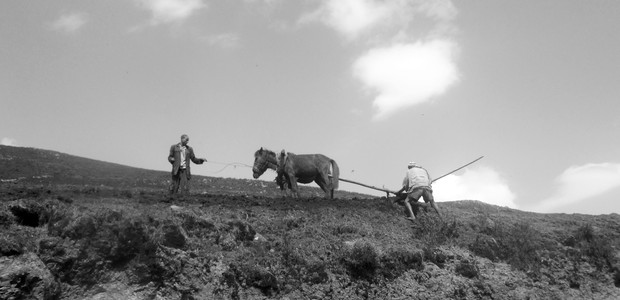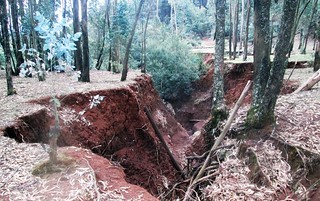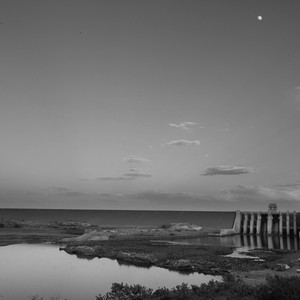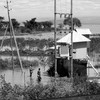ReviewChoke Mountain sediments stifle downstream reservoirs

At an elevation of over 4,000 metres, Choke Mountain in the tropical alpine environments in Ethiopia’s Amhara region is experiencing rapid population growth, deforestation, land degradation and seasonal flooding.
The Choke watershed is the water source for the Upper Abay (Blue Nile) river system, which includes more than 59 rivers and 273 springs.
Belachew Miherete, a 52-year-old farmer, has five children and works on his father’s farm. “I have been farming with my father and getting crops and produce from his land,” he said. Belachew, like other farmers in the area, underlined that the Choke’s regional ecosystems are deteriorating as the climate warms.
“We are suffering as flooding washes away the soil with our seeds during ‘Kiremet’ (Winter),” he said.
Choke means “very cold” in Amharic. Until about 20 years ago it was covered with a glacier, but these days it is rare to see snow and frost, not to mention vegetation like the giant lobelia gibberoa tree which was traditionally found in the region.
The Choke Mountain ecosystems are also under pressure as agriculture reduces biodiversity and the alpine zone retreats. Land use pressures of a growing population are affecting the agro-ecological systems.
Land degradation associated with over-cultivation impacts watershed-wide erosion rates and affects the quality of water for downstream users, including the Great Ethiopian Renaissance Dam.
We are suffering as flooding washes away the soil with our seeds.”
Siltation, the increasing amount of sand and other particles in the water, increasingly affects the downstream countries Sudan and Egypt.
According to a United Nations Office for the Coordination of Humanitarian Affairs (OCHA) report of 2019, higher than average rainfall during the first weeks of August triggered flooding in South Gondar Zone in the Amhara region of Ethiopia and killed two people and inundated many households.
The flooding occurred in the Fogera and Libo Kemekem districts on August 11 and 12, and is attributable to the overflow of the rivers that are tributaries of Lake Tana and the Blue Nile. Reportedly 25,000 people were affected, 6,653 houses were flooded, 18 schools were damaged, and 3,428 hectares of crop-areas were covered by water.
This year the pattern was repeated, and the damage was even worse. On the same dates in August, a large number of communities were affected, but the extent of the damage has not yet been officially announced.
Local livelihoods on the line
Studies by Debere Markos University reveal that the Choke Mountain watersheds have been facing flooding and erosion resulting from population growth, settlement, overgrazing, deforestation, and unsustainable agricultural practices.
The Choke agro-ecological problems have been noted by environmentalists, government and non-governmental organisations, sparking a series of initiatives and projects.
Debre Markos University and Addis Ababa University have conducted several surveys, identifying socioeconomic aspects of the Choke Mountain communities. “We have conducted a research on what kind of livelihood options are recommended to avert the existing severe ecological problems,” said Abiyot Molla, Director of Choke Watershed Research Project Development Department at Debre Markos University.
The university is working with East Gojjam Zone Rural Land Administration Authority and the Federal Environment Commission’s project office of Mainstreaming Incentives for Biodiversity Conservation funded by the Global Environment Facility.
Extreme rainfall has been a significant problem in the Choke watersheds, causing floods that can significantly damage agriculture, ecology, infrastructure, disruption to human activities and the loss of property, especially downstream of the watersheds.
The high cost of sedimentation
Sudan and Egypt have been building many dams along the Nile for various purposes, valid experiences upstream riparian countries, including Ethiopia, should take into account.
According to Dr Eng Manaye Ewenetu, Associate Engineer at Me Consulting Engineers, siltation of these reservoirs has been a major issue for storage and the structural integrity of the dams. The sedimentation, within their reservoirs, reduces their storage capacity and their effective life span, he said.
He also mentioned that the Sennar Dam built on the Blue Nile in Sudan for irrigation purposes has lost more than 60 percent of its original water storage capacity due to the sediment deposition over 61 years, according to publicly available studies.
The Roseires Dam, which was constructed on the Blue Nile (Sudan) to store water for irrigation lost 36 percent of its original water storage capacity over 28 years.
The High Aswan Dam Reservoir (Lake Nasser) has a total length of about 500 kilometres (350 kilometres inside Egypt and 150 kilometres inside Sudan). More than 124 million tons of sediment per year is deposited in the Lake Nasir reservoir, which has reduced the reservoir volume tremendously.
Sedimentation is seen as a critical problem for Ethiopia, and it could cost millions of dollars to avoid the silts from the Grand Ethiopian Renaissance Dam’s reservoir.
However, according to experts, the Grand Ethiopian Renaissance Dam will substantially reduce the sedimentation problem to reservoirs in Sudan and Egypt.
“This will directly benefit the downstream countries with additional agricultural production, energy generation, river navigation and water supply”, Dr Manaye said.
The ecosystem is not just invaluable for Ethiopia.”
As the Nile is a shared river, both the Ethiopian government and several academics call on basin countries to share responsibility for conserving the environment.
More ambitiously, the Ethiopian government also wants countries downstream of the Nile, including Sudan and Egypt, to contribute financially towards maintaining Choke’s ecosystem services.
Some 85 percent of the Nile River emerges from the Ethiopian highlands. “Choke Mountain by itself contributes more than 10 percent of the Nile water. So the ecosystem is not just invaluable for Ethiopia – the downstream countries Sudan and Egypt should also take a share in the problems facing this landscape and act accordingly,” said Abiyot.
Adding legal support to this argument, Article 2 of the Convention on the Protection and Use of Transboundary Watercourses and International Lakes (Water Convention) also states that “the Parties shall take all appropriate measures to prevent, control and reduce any transboundary impact”.









